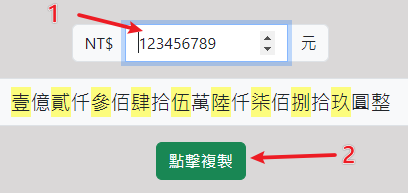Convert Numbers to Chinese Uppercase (New Taiwan Dollar)
Chinese Number Table
| Arabic Numerals | 0 | 1 | 2 | 3 | 4 | 5 | 6 | 7 | 8 | 9 | 10 | 100 | 1000 |
|---|---|---|---|---|---|---|---|---|---|---|---|---|---|
| Traditional Chinese Uppercase | 零 | 壹 | 貳 | 參 | 肆 | 伍 | 陸 | 柒 | 捌 | 玖 | 拾 | 佰 | 仟 |
| Traditional Chinese Lowercase | ○ | 一 | 二 | 三 | 四 | 五 | 六 | 七 | 八 | 九 | 十 | 百 | 千 |
- This is an online generator for numbers and Chinese uppercase numerals.
- Enter Arabic numerals to convert to Chinese uppercase.
Use Example

Why use Chinese uppercase numerals?
Uppercase numerals use redundancy for security. Each character has many strokes, making it hard to alter or misread, even if partially erased.
Nowadays, people type on computers for long periods, making it easy to write the wrong characters. Every time you issue an invoice/check, fill out a tax form, or withdraw money at the bank, you often need to write amounts in uppercase.
Various bills, checks, and settlement vouchers filled out by banks, organizations, and individuals are important for payment settlement and cash transactions, directly related to accuracy, timeliness, and security. These documents serve as accounting vouchers and written proof of economic responsibility. Therefore, they must be standardized and regulated: complete elements, correct numbers, clear handwriting, no omissions or errors, and prevent alterations.
Chinese uppercase amount numerals should be written in regular or running script. Traditional: '壹、貳、參、肆、伍、陸、柒、捌、玖、拾、佰、仟、萬、億、圓、角、分、零、整'; Simplified: '壹、贰、叁、肆、伍、陆、柒、捌、玖、拾、佰、仟、万、亿、元、角、分、零、正'. Do not use simplified or self-created characters. If both traditional and simplified are used, it is acceptable.
The correct way to write RMB/HKD/TWD uppercase should also pay attention to the following:
- If the Chinese uppercase amount ends with '元' (or '圓'), write '整' (or '正') after it; after '角', '整' (or '正') is optional; if there is '分', do not write '整' (or '正') after it.
- The currency name (RMB/HKD/TWD) should be indicated before the Chinese uppercase amount, and the amount should be written immediately after, with no space.